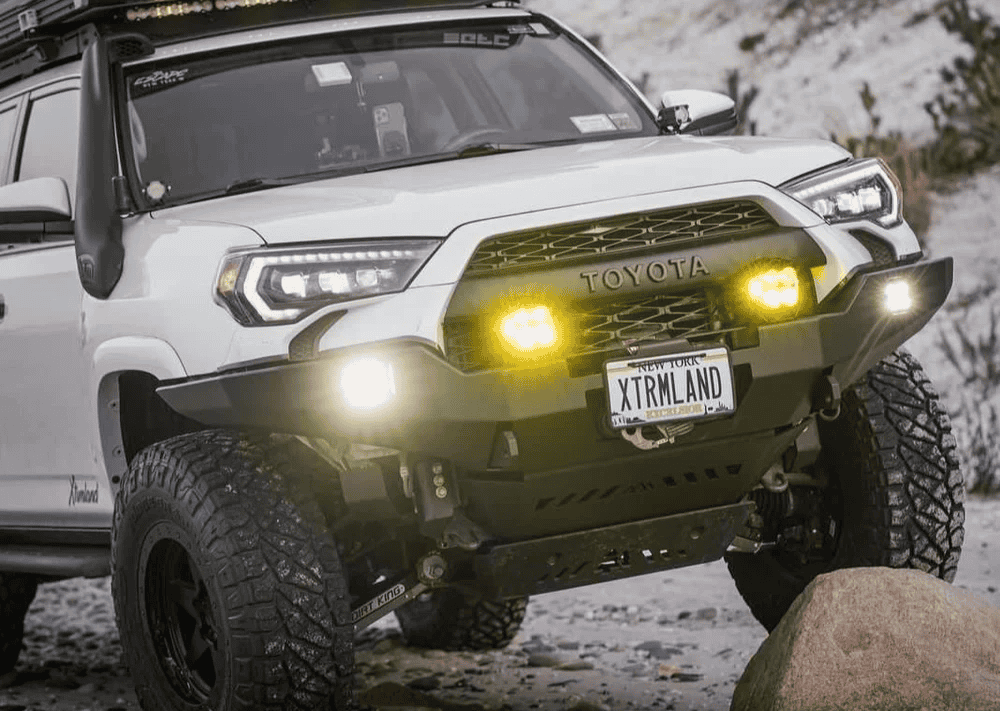Overland Vehicles

The Bronco Raptor starts with wide track suspension, long travel dampers, and 37 inch all terrain tires that shrug off sharp rock and sand wash chatter. Its twin turbo V6 and 10 speed automatic keep the powerband accessible while low range and locking differentials provide controlled crawling. Approach and departure angles remain generous, so bumpers clear shelves and berms without drama. Skid plates and reinforced components resist trail hits that would sideline lighter builds.
On mixed terrain, the factory tuning shines. Fox live valve dampers adapt quickly to surface changes, letting the chassis float across washboard and then settle when speed drops for technical climbs. Tire pressure management is a big lever here. Airing down expands the footprint for grip and ride quality, then airing up protects sidewalls before pavement stints.
Range is the one area many owners address early. High traction tires, added gear, and headwinds can cut fuel economy. Plan routes with reliable refuel points or carry compliant external fuel solutions that secure outside the cabin. Keep weight low and between the axles to avoid pendulum effect on off camber trails.
The widened control arms, heavy duty steering, and stronger half shafts reduce the chance of trail breakage. That strength does not remove the need for careful driving. Pick lines that avoid repeated full stuff events, and keep an eye on heat in sand or long hill climbs. When adding weight, consider spring rate and damping changes to maintain proper ride height and rebound control. Re tune alignment to account for added mass and front accessory weight so the truck tracks straight on long highway sections.
Payload is finite. Check the door jamb sticker for your exact figure and subtract passengers and aftermarket parts to reveal usable capacity. Roof load ratings have two numbers, dynamic and static. The dynamic rating is lower and governs driving. Heavy items belong on the floor, tied to solid points. Keep the roof for lighter and bulky items like soft gear or a compact tent system that respects dynamic limits. Verify rack ratings match the roof panel and mounting design, then match your cargo plan to real world numbers.
Modern overland travel depends on stable power. A compact lithium battery with a smart DC charger can run fridge, comms, lights, and small tools. Protect wiring from abrasion, fuse every circuit, and use marine grade connectors. For water, seven to ten gallons covers a long weekend for two with mindful use. A food grade tank with proper venting and a reliable pump keeps things simple. Communications matter once cell coverage fades. Handheld radios, a satellite messenger, or a small satellite internet terminal provide weather, mapping updates, and emergency contact.
Start with protection. A front solution that preserves cooling and approach angle paired with skid plates under vital parts saves trips. Rock rails keep the body straight in tight canyons. Recovery gear should be ready, not buried. A quality jack base, rated ropes and soft shackles, and proper anchors give you options when conditions change. Lighting can be simple yet effective. Wide cornering lights low on the bumper help in dust and fog. A controlled warm beam up high extends sight lines without glare.
Tire choice is your foundation. The stock 37s are tough, but replace on time and choose a load rating that matches vehicle mass. Carry a full size spare and tools for trail repairs. Brake laterals on long descents with engine braking and proper gearing to keep heat in check.
Inside, storage should stop rattles and speed up camp setup. Use drawers or cases that lock closed, and keep the heaviest items over the rear axle. A flat sleeping deck is possible for one with careful packing, but many drivers prefer a compact roof tent within the dynamic roof limit. Ventilation, bug screens, and a quiet fan make nights restful in humid or dusty conditions.
A cohesive build plan prevents weight creep and duplicated functions. Define your longest trip, your coldest night, and your most remote refuel. Then size power, water, and storage to those realities. Route wiring cleanly, seal penetrations, and choose components with proven durability in heat, cold, and vibration. Avoid stacking high racks, heavy tents, and large awnings if you also carry fuel, water, and recovery tools. Keep tires at correct pressure for weight, and recalibrate speedometer if needed to keep range estimates honest.
If you want guidance from a team that lives this world, explore our overland rigs to see how a purpose built setup comes together without guesswork. Our shop designs balanced systems, from electrical and water to protection and storage, then installs them with an eye for serviceability. For tailored upgrades on an existing Raptor, see our custom overland upfit options that respect payload and geometry. Curious about process and support after delivery? Learn more at why choose OZK Customs.
Bring your routes and your must haves. We will translate them into a Bronco Raptor overland rig that rides level, sips power, and keeps essentials easy to reach. Your build should feel natural on the trail and calm on the highway. Share your timeline and goals, and we will craft a plan that fits.
Ready to turn your Bronco Raptor into a purpose built overland rig? Our team designs and installs power, water, protection, racks, and communications that work together. Share your goals and timeline, and we will map a build plan that fits your routes and your budget.
ADDRESS:
6159 E Huntsville Rd, Fayetteville, AR 72701
PHONE:
(479) 326-9200
EMAIL:
info@ozkvans.com